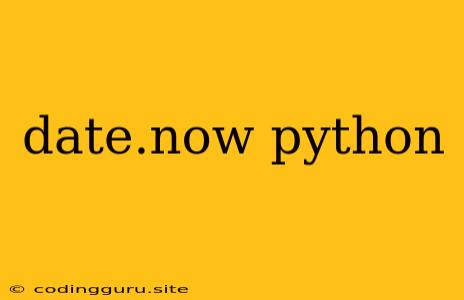Getting the Current Date and Time in Python: A Comprehensive Guide
Python's extensive libraries offer a variety of ways to work with dates and times. One crucial function for many tasks is date.now, which allows you to retrieve the current timestamp. Let's explore how to use this function effectively in your Python projects.
What is date.now?
date.now is not a built-in function in Python. However, it represents a common approach to getting the current date and time, often using a combination of libraries and methods. In essence, you'll use a library that provides a function or method named now (or similar) to access the current timestamp.
Understanding the datetime Module
The standard Python library provides a powerful tool for working with dates and times: the datetime module. This module offers a suite of classes and functions to handle various date and time operations.
datetime.datetime.now() is the key function for getting the current date and time. Here's how it works:
import datetime
current_datetime = datetime.datetime.now()
print(current_datetime)
This code will output the current date and time in the format YYYY-MM-DD HH:MM:SS.mmmmmm.
Formatting Output for Readability
The default output of datetime.datetime.now() can be somewhat cumbersome. Python allows you to customize the output using the strftime method.
Example:
import datetime
current_datetime = datetime.datetime.now()
formatted_date = current_datetime.strftime("%Y-%m-%d %H:%M:%S")
print(formatted_date)
This code formats the output to display the date and time in a more readable format: YYYY-MM-DD HH:MM:SS.
Working with Specific Components
You can access individual components of the date and time using attributes:
Example:
import datetime
current_datetime = datetime.datetime.now()
year = current_datetime.year
month = current_datetime.month
day = current_datetime.day
print(f"Today's date is: {year}-{month:02}-{day:02}")
This code extracts the year, month, and day from the current datetime object and prints them in a user-friendly format.
Conclusion
By understanding the datetime module and its now() function, you gain the ability to seamlessly incorporate current date and time information into your Python projects. Whether you need to log events, track timestamps, or simply display the current time, date.now (implemented through the datetime module) offers a powerful and versatile solution.
